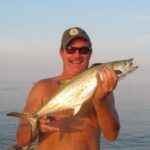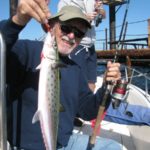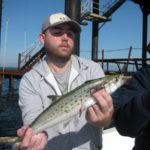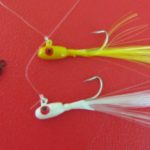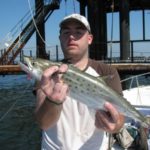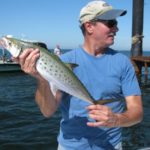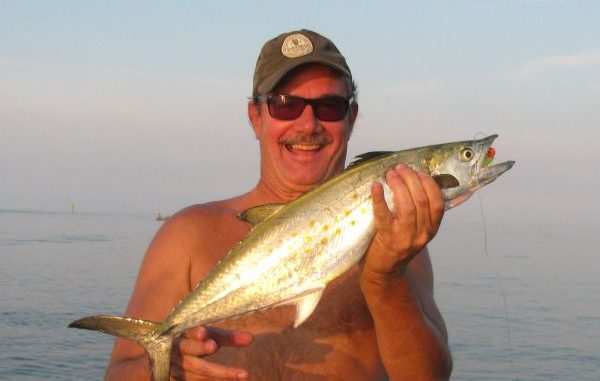
Most Louisiana anglers turn their noses up to all mackerels, but the nearshore rigs are teeming with Spanish mackerel. And these anglers know they are some of the tastiest fish in the Gulf.
“Not the trailer bearings again!” Artie groaned as we rumbled onto the shoulder amidst a cloud of smoke.
“Just what we need now!” Pelayo growled as he jerked the truck door open and scurried out for a look.
But when Artie and I reached him, kneeling down by the trailer, Pelayo was actually smiling.
“Hah!” he laughed amidst the miasma of burning rubber. “Ain’t nothing serious. This was caught under the fender!”
And he held up the crumpled top of a little Playmate ice-chest.
“That was the little bump we felt about a mile back,” he explained.
“Whoo-boy!” Artie exhaled while cupping his hands in prayer mode. “Good thing, too. ’Cause I sure wasn’t up to — wellm we all know how that goes.”
We all sighed, slapped backs and climbed back in the truck. Our “mack attack,” (a fishing trip actually targeting Spanish mackerel at the shallow rigs) was still on.
“That’s why I used to love hoists,” Artie smirked as we got going again. “Man, trailer maintenance sure was easier when your trailer stayed out da waaw-da!”
“And man!” Pelayo reminisced. “Everybody had a hoist back then! Lionel’s place at Da Island, Pip’s Place in Hopedale, Blackie Campo’s ….”
“And Delta Marina at Empire, “ Eddie chimed in. “Battistela’s at Empire, before them — Joshua’s at Buras, Hi-Ridge in Port Sulphur — even PJ had one at Riverside in Buras where he dropped your boat right in da river waaaw-da! Man nobody used back-down ramps in doze days!”
“Even Venice had one at that Ellzey’s place,” Eddie said.
“But launching there was risky,” recalled a chuckling Pelayo. “’Cause you never knew if the hoist guy was gonna show up! He liked to very graciously launch you and charge you — then in late morning he’d skip out. So you had to use the back-down ramp to get your boat out da waaaw-da — which was no piece of cake!”
“Then on other days,” Artie remembered, “he’d skip out the early morning, so you had to launch on the ramp. But then he’d very graciously show up later to very graciously hoist you out, and charge you! Either way, he made out like a bandit. You ’unnerstan’ what I’m saying? Ya follow me?”
“Then finally came Venice Marina!” Eddie added. “With a nice, reliable hoist operation, for a while anyway.”
“And all those hoist guys were true artists!” said Artie. “In two minutes flat they got your boat in or outta da waaaw-da! “
Which was not the case with the folks we found attempting to pull out their boat at the back-down ramp as we prepared for our “mack attack” at the shallow West Delta rigs.
Tidal conditions and the usual hocus-pocus aren’t a big issue on these type fishing trips. The only issue is getting offshore. The macks are always there — and ravenous — this time of year.
So, as usual, we slept in and got a late-morning start. Hence many fisherfolks were already returning as we prepared to launch.
But it’s not often you see a Prius trailering a boat in South Louisiana. Its wheels spun and squealed as we waited our turn at the ramp.
The outboard on the 18-foot bay boat behind it roared, but nothing moved. Neither car nor boat was budging on that back-down ramp, which we’d always found excellent for both its angle and traction.
But the pot-bellied guy at the boat’s wheel wouldn’t give up. Grimacing and baring his teeth, he jammed the throttle forward — wrrrooommm!!! blub-blub-blub —WROOOMM!!-blub-blub-blub.
The prop sent up a huge geyser of bubbles and spray as the 150-horsepower outboard erupted with a hellacious valve-threatening roar.
Pelayo looked at me and grimaced, hunching his shoulders, as if bracing himself for something catastrophic (or hilarious).
“Gunnit!” the guy at the throttle yelled at the blond woman driver, but you could barely hear him over the racket. His red, contorted face gave away the urgency of his words, however. Sweat beaded on his forehead and dripped off his double chin as he bobbed his head and grimaced.
But still he wasn’t moving.
The Prius’ wheels kept spinning, squealing, smoking. The stench of burnt rubber wafted through the humid, smoke-filled air. The woman at the wheel seemed to be looking in the rear-view mirror as she gunned the gas pedal. Her partner finally raised both hands and opened his palms.
“Hold it!” he bellowed.
His crazed pantomime had switched gears.
“STOP! Stop, I said!” he bellowed. “You’re GONNA …”
But the woman kept her foot on the gas as more smoke billowed. So the guy in the boat started losing it, banging the console with both fists, screaming hoarsely.
Finally he apparently decided to drive the car himself. He turned, put one hand on the gunwale and started leaping over it like a gymnast on a row bar.
But he wasn’t built like a gymnast. He came over the side of the boat alright, and then his wet sneakers hit the trailer’s wet fender.
“Whooaaa!”
His flabby, sunburnt arms flailed the air helplessly, grabbing for the gunwale to no avail. He hit the fender with his stomach and chin, and then rolled off into the shallow water and algae, where he thrashed and wallowed like a beached manatee.
By now Pelayo was wading over to lend a hand, and I’d raced over to bang on the woman’s window. She looked through the window wide-eyed. Then she looked in the mirror and gaped.
With one hand she covered her mouth, with the other she jerked the shift into park. Then she fumbled with the door handle and finally pushed violently on the door, whacking me smartly on the arm and stomach as she leaped from the driver’s seat.
“Oh my!” she gasped. “Oh my! What?”
Her sunglasses sat askew on her pretty face. Her eyes were wild, and her hand still covered her mouth. Her big hoop earrings jangled as she raced to the water’s edge in her flip-flops.
“Bob!” she gasped. “Oh Bob! I thought?”
Big Bob was finally upright and shuffling toward us.
“What the heck ya TRYING …?”
But he stopped in mid-bellow and shook his head disgustedly, leaning on the boat’s bow for a breather. His hat was gone, floating behind him, and his wet hair stood up like Don King’s. His arms, shirt and cheeks were smeared with green algae.
He was a sight.
“But honey,” the woman whined, “I was just doing what you said? Didn’t you …?”
“I NEVER said to burn the wheels up!” Bob started walking, getting fired up again. “I told you to WATCH me in the rear view!”
His steps were matching the tempo of his voice as he sloshed forward, stomping furiously, cursing loudly.
But, as we all know, that algae can make ramps slippery. He started losing his footing again, leaning forward, throwing his arms out in front of him, but he kept pumping his legs. No traction, though. He was pumping away like on a treadmill at the health club. His body started swaying and weaving. He turned into a ringer for John Belushi as Jake in the Blues Brothers — same energetic dance steps.
Then his arms with the bleeding elbows were up over his head, flailing the air crazily on either side of his head. His stocky little legs were going a mile a minute as his arms danced overhead — Blues Brother Jake, for sure.
Finally — sploooosh! — down again.
Pelayo and I rushed over; each grabbed an algae-smeared arm, and helped Big Bob upright.
“Oh Bob!” The woman’s voice cracked, and she buried her face in her hands.
She was doubled over gasping, her tanned shoulders heaving. Then she turned around and started slapping the air with one hand while covering her mouth with the other, still doubled over.
Finally, she gave up and turned around to face us. Turned out the woman was in hysterics! She was laughing her butt off! Her face was red and contorted in mirth. While trying to catch her breath, she wiped her reddened cheeks free of laugh-tears.
Her hilarity was contagious. So Pelayo, Artie, Eddie and I looked around for clearance and also exploded in cackles.
Heck, we’d been holding it in long enough.
“Mind if I try?” Pelayo said, pointing at the Prius after he caught his breath. So he got at the wheel while Artie and Eddie got in the back seat.
In seconds the boat was out.
Turned out, Bob and Betty were from Birmingham, and had just experienced, “a simply wonderful fishing trip!” They were jubilant with the 15 Spanish mackerel they’d caught “at the first rigs they came to out the jetties.”
“We can’t wait to get a couple on the broiler tonight!”
They explained that even half that catch while fishing off Destin (their normal fishing locale) would be a “humdinger” of a trip.
Yes, they had to be out-of-staters. You don’t hear that sort of thing about Spanish mackerel from too many Louisianans.
For the life of us, we’ve never understood why Louisiana fishermen habitually pass up these rigs (the 35- to 60-foot-deep ones from Ship Shoal through Fourchon through the Grand Isle blocks to West Delta) on the way to the deeper ones in late summer.
The action at these close rigs is as hot as anywhere and comes with medium-spinning tackle, short wire leaders and jigs.
This ain’t rocket science.
Spanish mackerel hang at our shallower rigs most of the year, but we always do best in mid- to late summer. We always catch the biggest ones in July and August.
They’re spawning this time of year. The big ones we catch (the 3- to 5-pounders) are all laden with eggs.
And you talk about a battle! Here’s a veritable missile of a fish. I’ll put a 2-pound Spanish against an 8-pound trout any day — not that I’ve ever caught a speck that size.
You hook up to these shallow rigs in winter and spring, cast out shrimp-tipped jigs — you’ll have some dynamite fishing.
But the Spanish are in big, tight schools. And those are generally smaller Spanish than now in summer.
So in winter/spring, it seems you get your line snapped twice for every Spanish you boat. What happens is, while you’re fighting one, another in the school grabs the swivel on your leader that’s twirling around or just grabs the line out in front of it.
Using black swivels, with a short wire leader helps, as does simply tying 30-pound fluorocarbon (without a swivel) directly to the 15- to 20-pound-test on your medium spinning reel.
Alas, in the summer the Spanish aren’t schooled up as tight. The fish are much bigger and more spaced out, not in tight schools.
It’s the ideal time to battle them one on one. The only thing you really need is good green, salty water.
You won’t catch many Spanish in muddy river-roiled Gulf waters, even if the muddy layer is on top. Spanish feed near the surface, so they want the water salty and clear all the way up.
Given the high river the last few years into early summer, our best Spanish fishing has come in late summer, after the river drops.
Near the jetties, we pulled over, as usual, to pick up some little pogies and croakers from a shrimp boat that was anchored and culling its catch.
Yes, these little fish were all dead, but no matter. We like to hook them on a ¼-ounce jighead and cast them out. It usually doesn’t take long for a Spanish or bluefish to smack ’em.
Bluefish, however, have been scarce at the shallow rigs lately, where they used to swarm.
We hit the Gulf and looked at each other smiling. The weather forecast had been spot-on for a change. One- to 3-foot seas!
We skimmed easily over the gentle swells, and noticed the water getting a pretty green only five miles from shore.
Perfect.
In minutes, we tied up to a rig at WD 31s, and the gentle breeze carried us right under the shade.
Perfect again!
Two tandem shad rigs were being cranked halfway back on spinning tackle when the poles bowed.
“Don’t take long!” Artie screeched as his pole bowed.
“Me TOO!” howled Eddie from beside him.
The fight was on. The battle had been joined. And all it took was three casts with shrimp-tipped shad rigs.
Spanish love anything shiny or white. In a frenzy, sure, they’ll hit anything, but after years of targeting them we’ve found that white beetles or shad rigs or shiny spoons work best.
Jerk them back on the retrieve violently. Spanish macks usually smack it in between jerks.
Short wire leaders and black swivels in front of these offerings will save you some bucks, too.
After a ferocious flurry of runs mixed with some surface thrashing, Artie heaved his fish aboard. Eddie quickly followed — but with a double.
“Watch those teeth!” Pelayo reminded them as they started prying out the hooks. “Here, use the pliers. Save yourself some pain.”
“Another Spanish here!” Pelayo soon roared from behind me. “Whooo-whooo!”
He held his rod high overhead, savoring every sizzling second of the maniac’s berserk run.
How so many Louisianans pass up these fish we’ll never understand.
I cast out with a white, shrimp-tipped beetle in front of a wire leader, let it sink a bit into the green 40-foot depths and started jerking it back. It took all of three jerks, and the battle was joined.
Spanish really SMACK a bait. They hit it on the run — and keep running!
This is nothing like a flounder taking your cork down ever-so-slowly, or the tap-tap of a bass on a worm. No sir!
Complete bedlam soon reigned in our boat. In 20 minutes we’d swung aboard six Spanish mackerel of between 2 and 4 pounds.
Then came a pompano — some very welcome lagniappe!
They often “hang” with schools of Spanish at these shallow rigs. They also love shrimp-tipped shag rigs, as any vintage rig-fisherman will attest. Look up old Conservationist magazines and By Hek and Mac Fadden Duffy articles for proof.
Two and a half hours later we had to stop. We’d fished all of two rigs in 40-foot depths.
“Da Box” was nearly full, although we weren’t close to our four-man limits (15 Spanish per person.)
Still, our arm muscles were twitching and cramping.
On the way in, nobody felt like stopping for trout over the oyster reefs in Scofield or Shell Island bays. After the reel-screaming, pole-bending frenzy of the past few hours, any speck action would have seemed woefully anti-climatic.
And, oh,just in case you were wondering: The Times-Picayune Creole Cookbook (circa 1911) regarded Spanish mackerel thusly: “A delicate and delicious fish far superior to any mackerel in the world — on equal footing with the pompano.”
The key is to eat them (fried, broiled, seared) when fresh, preferably before freezing.
But it’s by NO means a deal-breaker to vacuum-freeze the fillets for a few weeks.
